Predicting the Invasion Range of the Common Myna, Acridotheres tristis Linnaeus, 1766 in Egypt under Climate Change
Abstract
:1. Introduction
2. Materials and Methods
2.1. Study Area
2.2. Mapping and Environmental Data Selection
3. Model Validation
4. Result
4.1. Spatial Prediction Model of Common Myna in Egypt under Current Conditions
4.2. The Effect of Environmental Variables on Species Distribution Model of Common Myna in Egypt under Current Conditions
4.3. The Predicted Invasion Range of Common Myna under Future Global Warming Scenarios in Egypt
4.4. Analysis of the Suitable Distribution Center for Common Myna under Future Climate Scenario
5. Discussion
6. Conclusions
Author Contributions
Funding
Institutional Review Board Statement
Informed Consent Statement
Data Availability Statement
Acknowledgments
Conflicts of Interest
References
- Burgiel, S.; Muir, A. Invasive Species, Climate Change and Ecosystem-Based Adaptation: Addressing Multiple Drivers of Global Change Global Invasive Species Programme; Global Invasive Species Programme (GISP): Nairobi, Kenya, 2010. [Google Scholar]
- Blackburn, T.M.; Essl, F.; Evans, T.; Hulme, P.E.; Jeschke, J.M.; Kühn, I.; Kumschick, S.; Marková, Z.; Mrugała, A.; Nentwig, W. A unified classification of alien species based on the magnitude of their environmental impacts. PLoS Biol. 2014, 12, e1001850. [Google Scholar] [CrossRef] [PubMed]
- Mainka, S.A.; Howard, G.W. Climate change and invasive species: Double jeopardy. Integr. Zool. 2010, 5, 102–111. [Google Scholar] [CrossRef] [PubMed]
- Finch, D.M.; Butler, J.L.; Runyon, J.B.; Fettig, C.J.; Kilkenny, F.F.; Jose, S.; Frankel, S.J.; Cushman, S.A.; Cobb, R.C.; Dukes, J.S. Effects of Climate Change on Invasive Species. In Invasive Species in Forests and Rangelands of the United States: A Comprehensive Science Synthesis for the United States Forest Sector; Springer: Berlin/Heidelberg, Germany, 2021; pp. 57–83. [Google Scholar]
- Charter, M.; Izhaki, I.; Mocha, Y.B.; Kark, S. Nest-site competition between invasive and native cavity nesting birds and its implication for conservation. J. Environ. Manag. 2016, 181, 129–134. [Google Scholar] [CrossRef] [PubMed]
- Feare, C.; Craig, A. Starlings and Mynas; Princeton University Press: Princeton, NJ, USA, 1999. [Google Scholar]
- Grarock, K.; Tidemann, C.R.; Wood, J.T.; Lindenmayer, D.B. Are invasive species drivers of native species decline or passengers of habitat modification? A case study of the impact of the common myna (Acridotheres tristis) on A ustralian bird species. Austral Ecol. 2014, 39, 106–114. [Google Scholar] [CrossRef]
- Gal, A. Attitude Construction toward Invasive Species through an Eco-Humanist Approach: A Case Study of the Lesser Kestrel and the Myna. Educ. Sci. 2023, 13, 1076. [Google Scholar] [CrossRef]
- Pagad, S.; Bisset, S.; Genovesi, P.; Groom, Q.; Hirsch, T.; Jetz, W.; Ranipeta, A.; Schigel, D.; Sica, Y.V.; McGeoch, M.A. The Global Register of Introduced and Invasive Species: Country Compendium. bioRxiv 2022, 2022-04. [Google Scholar] [CrossRef] [PubMed]
- Can Bilgin, C. First record of the common Myna (Acridotheres tristis) from Ankara, Turkey. Zool. Middle East 1996, 13, 25–26. [Google Scholar] [CrossRef]
- Bara, T. Bird notes from Lebanon, including two new species. Sandgrouse 2002, 24, 44–45. [Google Scholar]
- Holzapfel, C.; Levin, N.; Hatzofe, O.; Kark, S. Colonisation of the Middle East by the invasive Common Myna Acridotheres tristis L., with special reference to Israel. Sandgrouse 2006, 28, 44. [Google Scholar]
- Rabia, B.; El Din, M.B.; Rifai, L.; Attum, O. Invasive species breeding in Sinai, Egypt. Sandgrouse 2015, 37, 87–89. Available online: https://osme.org/wp-content/uploads/2023/07/Common-Myna-Acridotheres-tristis-a-new-invasive-species-breeding-in-Sinai-Egypt.pdf (accessed on 30 May 2024).
- Khoury, F.; Alshamlih, M. First Evidence of Colonization by Common Myna Acridotheres tristis in Jordan, 2013–2014. 2016. Available online: https://library.wcs.org/doi/ctl/view/mid/33065/pubid/PUB15555.aspx (accessed on 30 May 2024).
- Abd Rabou, A.F.N. Bird fauna encountered at the main campus of the Islamic University of Gaza, Gaza City, Palestine. Biodivers. J. Biol. Divers. 2019, 20, 604–614. [Google Scholar] [CrossRef]
- Magory Cohen, T.; McKinney, M.; Kark, S.; Dor, R. Global invasion in progress: Modeling the past, current and potential global distribution of the common myna. Biol. Invasions 2019, 21, 1295–1309. [Google Scholar] [CrossRef]
- Lowe, S.; Browne, M.; Boudjelas, S.; De Poorter, M. 100 of the World’s Worst Invasive Alien Species: A Selection from the Global Invasive Species Database; Invasive Species Specialist Group Auckland: Auckland, New Zealand, 2000; Volume 12. [Google Scholar]
- Grarock, K.; Tidemann, C.R.; Wood, J.; Lindenmayer, D.B. Is it benign or is it a pariah? Empirical evidence for the impact of the common myna (Acridotheres tristis) on Australian birds. PLoS ONE 2012, 7, e40622. [Google Scholar] [CrossRef] [PubMed]
- Dhami, M.K.; Nagle, B. Review of the Biology and Ecology of the Common Myna (Acridotheres tristis) and Some Implications for Management of this Invasive Species; School of Biological Sciences, The University of Auckland: Auckland, New Zealand, 2010. [Google Scholar]
- Craig, A.; Feare, C. Starlings and Mynas; A&C Black: Edinburgh, UK, 2010. [Google Scholar]
- Kumschick, S.; Gaertner, M.; Vilà, M.; Essl, F.; Jeschke, J.M.; Pyšek, P.; Ricciardi, A.; Bacher, S.; Blackburn, T.M.; Dick, J.T.A. Ecological impacts of alien species: Quantification, scope, caveats, and recommendations. BioScience 2015, 65, 55–63. [Google Scholar] [CrossRef]
- Bomford, M.; Sinclair, R. Australian research on bird pests: Impact, management and future directions. Emu 2002, 102, 29–45. [Google Scholar] [CrossRef]
- Faggi, A.; Dadon, J.R. Environmental problems associated with tourism activities in Punta Lara Natural Reserve (Argentina). Int. J. Environ. Sustain. Dev. 2011, 10, 19–29. [Google Scholar]
- Tidemann, C.R. Mitigation of the Impact of Mynas on Biodiversity and Public Amenity; School of Resources, Environment & Society, The Australian National University, 2001; Available online: https://fennerschool-associated.anu.edu.au/myna/minimise_files/Myna_Mitigation_PhaseI.pdf (accessed on 30 May 2024).
- Araújo, M.B.; Anderson, R.P.; Márcia Barbosa, A.; Beale, C.M.; Dormann, C.F.; Early, R.; Garcia, R.A.; Guisan, A.; Maiorano, L.; Naimi, B. Standards for distribution models in biodiversity assessments. Sci. Adv. 2019, 5, eaat4858. [Google Scholar] [CrossRef] [PubMed]
- Phillips, S.J.; Anderson, R.P.; Dudík, M.; Schapire, R.E.; Blair, M.E. Opening the black box: An open-source release of Maxent. Ecography 2017, 40, 887–893. [Google Scholar] [CrossRef]
- Phillips, S. A brief tutorial on Maxent, versions: 3.3.1. Lessons Conserv. 2016, 3, 108–135. [Google Scholar]
- Comino, E.; Fiorucci, A.; Rosso, M.; Terenziani, A.; Treves, A. Vegetation and Glacier Trends in the area of the Maritime Alps Natural Park (Italy): MaxEnt application to predict habitat development. Climate 2021, 9, 54. [Google Scholar] [CrossRef]
- Wang, R.; Jiang, C.; Liu, L.; Shen, Z.; Yang, J.; Wang, Y.; Hu, J.; Wang, M.; Hu, J.; Lu, X. Prediction of the potential distribution of the predatory mite Neoseiulus californicus McGregor in China using MaxEnt. Glob. Ecol. Conserv. 2021, 29, e01733. [Google Scholar] [CrossRef]
- Bertolino, S.; Sciandra, C.; Bosso, L.; Russo, D.; Lurz, P.W.W.; Di Febbraro, M. Spatially explicit models as tools for implementing effective management strategies for invasive alien mammals. Mammal Rev. 2020, 50, 187–199. [Google Scholar] [CrossRef]
- Raffini, F.; Bertorelle, G.; Biello, R.; D’Urso, G.; Russo, D.; Bosso, L. From nucleotides to satellite imagery: Approaches to identify and manage the invasive pathogen Xylella fastidiosa and its insect vectors in Europe. Sustainability 2020, 12, 4508. [Google Scholar] [CrossRef]
- Chang, Y.; Chang, C.; Li, Y.; Liu, M.; Lv, J.; Hu, Y. Predicting dynamics of the potential breeding habitat of Larus saundersi by MaxEnt model under changing land-use conditions in wetland nature reserve of Liaohe Estuary, China. Remote Sens. 2022, 14, 552. [Google Scholar] [CrossRef]
- Anderson, R.P.; Martínez-Meyer, E.; Nakamura, M.; Araújo, M.B.; Peterson, A.T.; Soberón, J.; Pearson, R.G. Ecological Niches and Geographic Distributions (MPB-49); Princeton University Press: Princeton, NJ, USA, 2011. [Google Scholar]
- Worthington, T.A.; Zhang, T.; Logue, D.R.; Mittelstet, A.R.; Brewer, S.K. Landscape and flow metrics affecting the distribution of a federally-threatened fish: Improving management, model fit, and model transferability. Ecol. Model. 2016, 342, 1–18. [Google Scholar] [CrossRef]
- Zhang, J.; Jiang, F.; Li, G.; Qin, W.; Li, S.; Gao, H.; Cai, Z.; Lin, G.; Zhang, T. Maxent modeling for predicting the spatial distribution of three raptors in the Sanjiangyuan National Park, China. Ecol. Evol. 2019, 9, 6643–6654. [Google Scholar] [CrossRef] [PubMed]
- Fick, S.E.; Hijmans, R.J. WorldClim 2: New 1-km spatial resolution climate surfaces for global land areas. Int. J. Climatol. 2017, 37, 4302–4315. [Google Scholar] [CrossRef]
- Tebaldi, C.; Debeire, K.; Eyring, V.; Fischer, E.; Fyfe, J.; Friedlingstein, P.; Knutti, R.; Lowe, J.; O’Neill, B.; Sanderson, B. Climate model projections from the Scenario Model Intercomparison Project (ScenarioMIP) of CMIP6. Earth Syst. Dynam. 2021, 12, 253–293. [Google Scholar] [CrossRef]
- Skeie, R.B.; Myhre, G.; Hodnebrog, Ø.; Cameron-Smith, P.J.; Deushi, M.; Hegglin, M.I.; Horowitz, L.W.; Kramer, R.J.; Michou, M.; Mills, M.J. Historical total ozone radiative forcing derived from CMIP6 simulations. Npj Clim. Atmos. Sci. 2020, 3, 32. [Google Scholar] [CrossRef]
- Nachtergaele, F.; van Velthuizen, H.; Verelst, L.; Batjes, N.H.; Dijkshoorn, K.; van Engelen, V.W.P.; Fischer, G.; Jones, A.; Montanarela, L. The harmonized world soil database. In Proceedings of the 2010 19th World Congress of Soil Science, Soil Solutions for a Changing World, Brisbane, Australia, 1–6 August 2010; pp. 34–37. [Google Scholar]
- Center for International Earth Science Information Network—CIESIN, Columbia University. Gridded Population of the World, Version 4 (GPWv4): Population Density; NASA Socioeconomic Data and Applications Center (SEDAC): Palisades, NY, USA, 2016. [Google Scholar] [CrossRef]
- Sulla-Menashe, D.; Friedl, M.A. User Guide to Collection 6 MODIS Land Cover (MCD12Q1 and MCD12C1) Product; Usgs: Reston, VA, USA, 2018; Volume 1, p. 18. [Google Scholar]
- De Smedt, I.; Romahn, F.; Eichmann, K.U.; Lambert, J.C.; Loyola, D.; Veefkind, J.P.; Dehn, A.; Zehner, C. S5P mission performance centre formaldehyde [L2_HCHO_] readme. Eur. Space Agency 2020, 7, 2021. [Google Scholar]
- Wei, B.; Wang, R.; Hou, K.; Wang, X.; Wu, W. Predicting the current and future cultivation regions of Carthamus tinctorius L. using MaxEnt model under climate change in China. Glob. Ecol. Conserv. 2018, 16, e00477. [Google Scholar] [CrossRef]
- Boyce, M.S.; Vernier, P.R.; Nielsen, S.E.; Schmiegelow, F.K.A. Evaluating resource selection functions. Ecol. Model. 2002, 157, 281–300. [Google Scholar] [CrossRef]
- Davis, M.A.; Grime, J.P.; Thompson, K. Fluctuating resources in plant communities: A general theory of invasibility. J. Ecol. 2000, 88, 528–534. [Google Scholar] [CrossRef]
- Keane, R.M.; Crawley, M.J. Exotic plant invasions and the enemy release hypothesis. Trends Ecol. Evol. 2002, 17, 164–170. [Google Scholar] [CrossRef]
- Soberón, J. Grinnellian and Eltonian niches and geographic distributions of species. Ecol. Lett. 2007, 10, 1115–1123. [Google Scholar] [CrossRef] [PubMed]
- Møller, A.P.; Díaz, M.; Flensted-Jensen, E.; Grim, T.; Ibáñez-Álamo, J.D.; Jokimäki, J.; Mänd, R.; Markó, G.; Tryjanowski, P. Urbanized birds have superior establishment success in novel environments. Oecologia 2015, 178, 943–950. [Google Scholar] [CrossRef]
- Elith, J. Predicting Distributions of Invasive Species. In Invasive Species: Risk Assessment and Management; Cambridge University Press: Cambridge, MA, USA, 2017; p. 10. [Google Scholar]
- Murray, J.V.; Stokes, K.E.; van Klinken, R.D. Predicting the potential distribution of a riparian invasive plant: The effects of changing climate, flood regimes and land-use patterns. Glob. Change Biol. 2012, 18, 1738–1753. [Google Scholar] [CrossRef]
- Gallien, L.; Douzet, R.; Pratte, S.; Zimmermann, N.E.; Thuiller, W. Invasive species distribution models–how violating the equilibrium assumption can create new insights. Glob. Ecol. Biogeogr. 2012, 21, 1126–1136. [Google Scholar] [CrossRef]
- Fraser, D.L.; Aguilar, G.; Nagle, W.; Galbraith, M.; Ryall, C. The house crow (Corvus splendens): A threat to New Zealand? ISPRS Int. J. Geo-Inf. 2015, 4, 725–740. [Google Scholar] [CrossRef]
- Mao, M.; Chen, S.; Ke, Z.; Qian, Z.; Xu, Y. Using MaxEnt to predict the potential distribution of the little fire ant (Wasmannia auropunctata) in China. Insects 2022, 13, 1008. [Google Scholar] [CrossRef] [PubMed]
- Elith, J.; Graham, C.H.; Anderson, R.P.; Dudík, M.; Ferrier, S.; Guisan, A.; Hijmans, R.J.; Huettmann, F.; Leathwick, J.R.; Lehmann, A. Novel methods improve prediction of species’ distributions from occurrence data. Ecography 2006, 29, 129–151. [Google Scholar] [CrossRef]
- IPCC. Climate change 2007: The physical science basis. Agenda 2007, 6, 333. [Google Scholar]
- Duenas, M.-A.; Hemming, D.J.; Roberts, A.; Diaz-Soltero, H. The threat of invasive species to IUCN-listed critically endangered species: A systematic review. Glob. Ecol. Conserv. 2021, 26, e01476. [Google Scholar]
- Avery, M.L.; Feare, C.J. Control or eradication: Problems in the management of invasive birds. In Invasive Birds: Global Trends and Impacts; CABI Wallingford UK: Wallingford, UK, 2020; pp. 350–362. [Google Scholar]
- Khoury, F.; Saba, M.; Alshamlih, M. Anthropogenic not climatic correlates are the main drivers of expansion of non-native common myna Acridotheres tristis in Jordan. Manag. Biol. Invasions 2021, 12, 640. [Google Scholar] [CrossRef]
- Zhang, S.; Lei, F.; Liu, S.; Li, D.; Chen, C.; Wang, P. Variation in baseline corticosterone levels of Tree Sparrow (Passer montanus) populations along an urban gradient in Beijing, China. J. Ornithol. 2011, 152, 801–806. [Google Scholar] [CrossRef]
- Pimentel, D.; Lach, L.; Zuniga, R.; Morrison, D. Environmental and economic costs of nonindigenous species in the United States. BioScience 2000, 50, 53–65. [Google Scholar] [CrossRef]
- Magory Cohen, T.; Hauber, M.E.; Akriotis, T.; Crochet, P.A.; Karris, G.; Kirschel, A.N.G.; Khoury, F.; Menchetti, M.; Mori, E.; Per, E. Accelerated avian invasion into the Mediterranean region endangers biodiversity and mandates international collaboration. J. Appl. Ecol. 2022, 59, 1440–1455. [Google Scholar] [CrossRef]
- Menon, M.; Mohanraj, R. Temporal and spatial assemblages of invasive birds occupying the urban landscape and its gradient in a southern city of India. J. Asia-Pac. Biodivers. 2016, 9, 74–84. [Google Scholar] [CrossRef]
- Shochat, E.; Lerman, S.B.; Katti, M.; Lewis, D.B. Linking optimal foraging behavior to bird community structure in an urban-desert landscape: Field experiments with artificial food patches. Am. Nat. 2004, 164, 232–243. [Google Scholar] [CrossRef] [PubMed]
- Pell, A.S.; Tidemann, C.R. The ecology of the common myna in urban nature reserves in the Australian Capital Territory. Emu-Austral Ornithol. 1997, 97, 141–149. [Google Scholar] [CrossRef]
- Hijmans, R.J.; Graham, C.H. The ability of climate envelope models to predict the effect of climate change on species distributions. Glob. Change Biol. 2006, 12, 2272–2281. [Google Scholar] [CrossRef]
- Bellard, C.; Bertelsmeier, C.; Leadley, P.; Thuiller, W.; Courchamp, F. Impacts of climate change on the future of biodiversity. Ecol. Lett. 2012, 15, 365–377. [Google Scholar] [CrossRef] [PubMed]
- Laczko, F.; Aghazarm, C. Migration, Environment and Climate Change: Assessing the Evidence; International Organization for Migration (IOM): New York City, NY, USA, 2009. [Google Scholar]
- El-Sharkawy, M.A. Climatological studies on temperature distribution in Egypt. Meteorol. Atmos. Phys. 1988, 39, 33–42. [Google Scholar]
- Streutker, D.R. A remote sensing study of the urban heat island of Houston, Texas. Int. J. Remote Sens. 2002, 23, 2595–2608. [Google Scholar] [CrossRef]
- Tobin, P.C. Managing Invasive Species. F1000Research 2018, 7, 1686. [Google Scholar] [CrossRef] [PubMed]
- Pluess, T.; Cannon, R.; Jarošík, V.; Pergl, J.; Pyšek, P.; Bacher, S. When are eradication campaigns successful? A test of common assumptions. Biol. Invasions 2012, 14, 1365–1378. [Google Scholar] [CrossRef]
- Woodford, D.J.; Richardson, D.M.; MacIsaac, H.J.; Mandrak, N.E.; Van Wilgen, B.W.; Wilson, J.R.U.; Weyl, O.L.F. Confronting the wicked problem of managing biological invasions. NeoBiota 2016, 31, 63–86. [Google Scholar] [CrossRef]
- Moffitt, L.J.; Osteen, C.D. Prioritizing invasive species threats under uncertainty. Agric. Resour. Econ. Rev. 2006, 35, 41–51. [Google Scholar] [CrossRef]
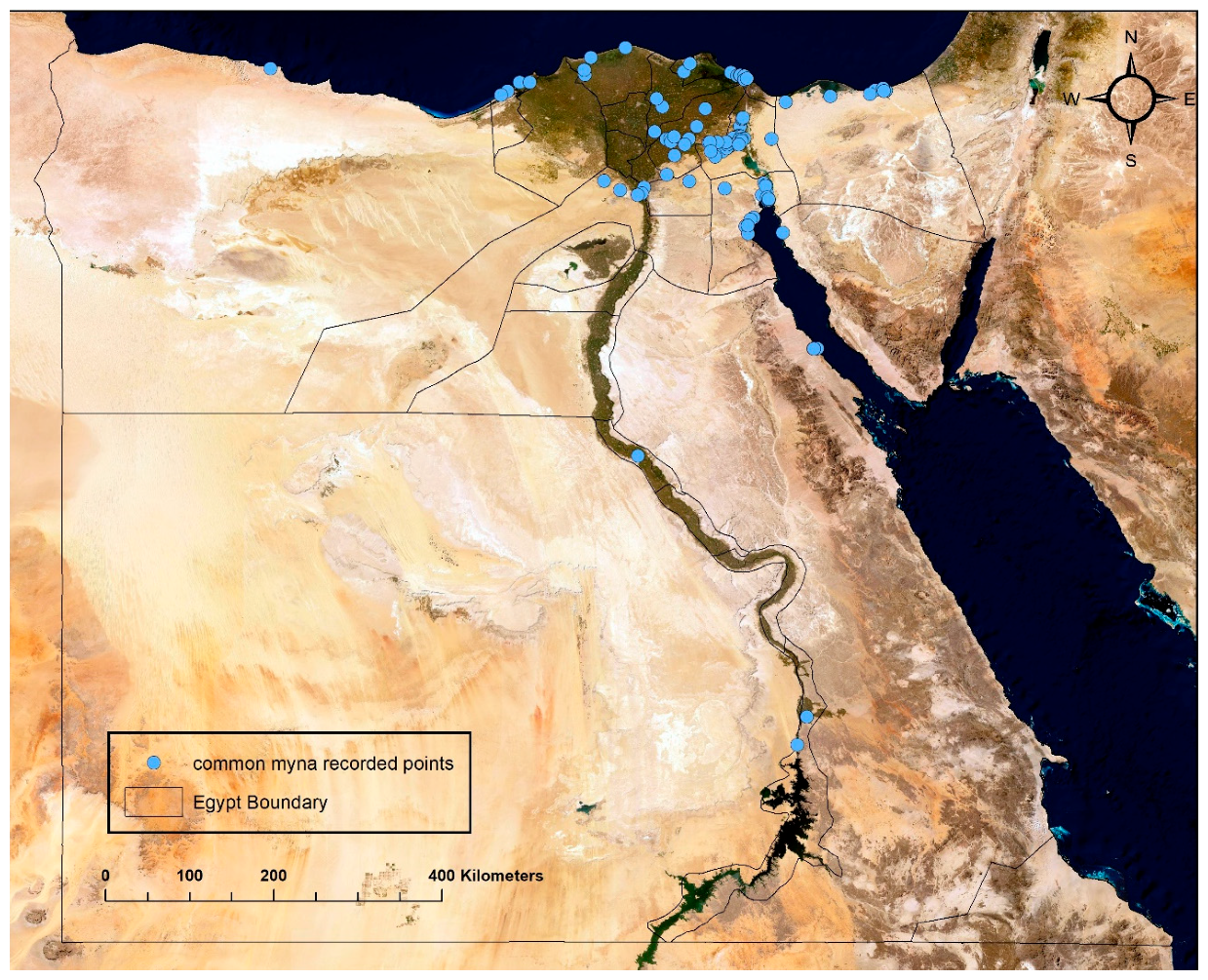
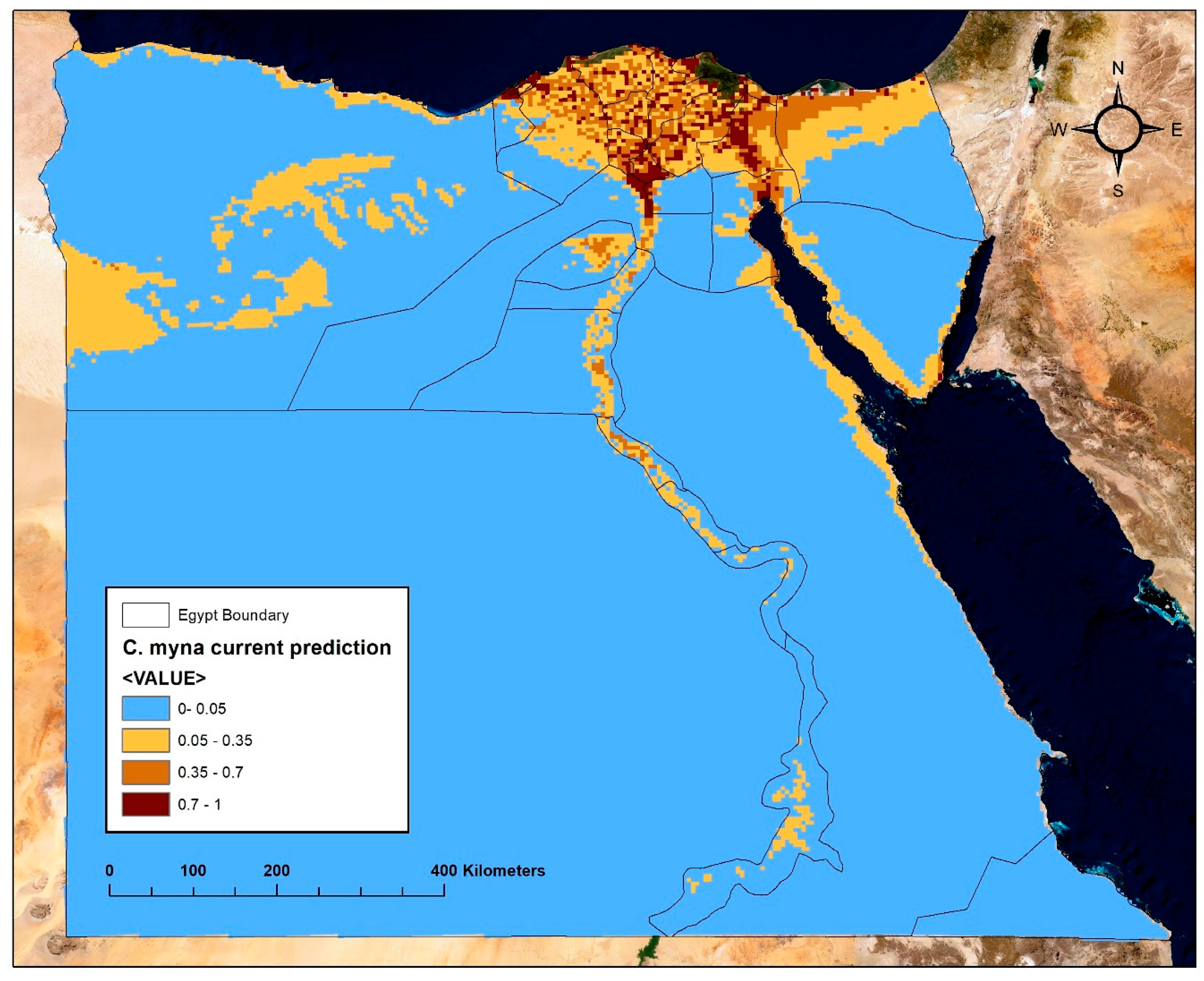

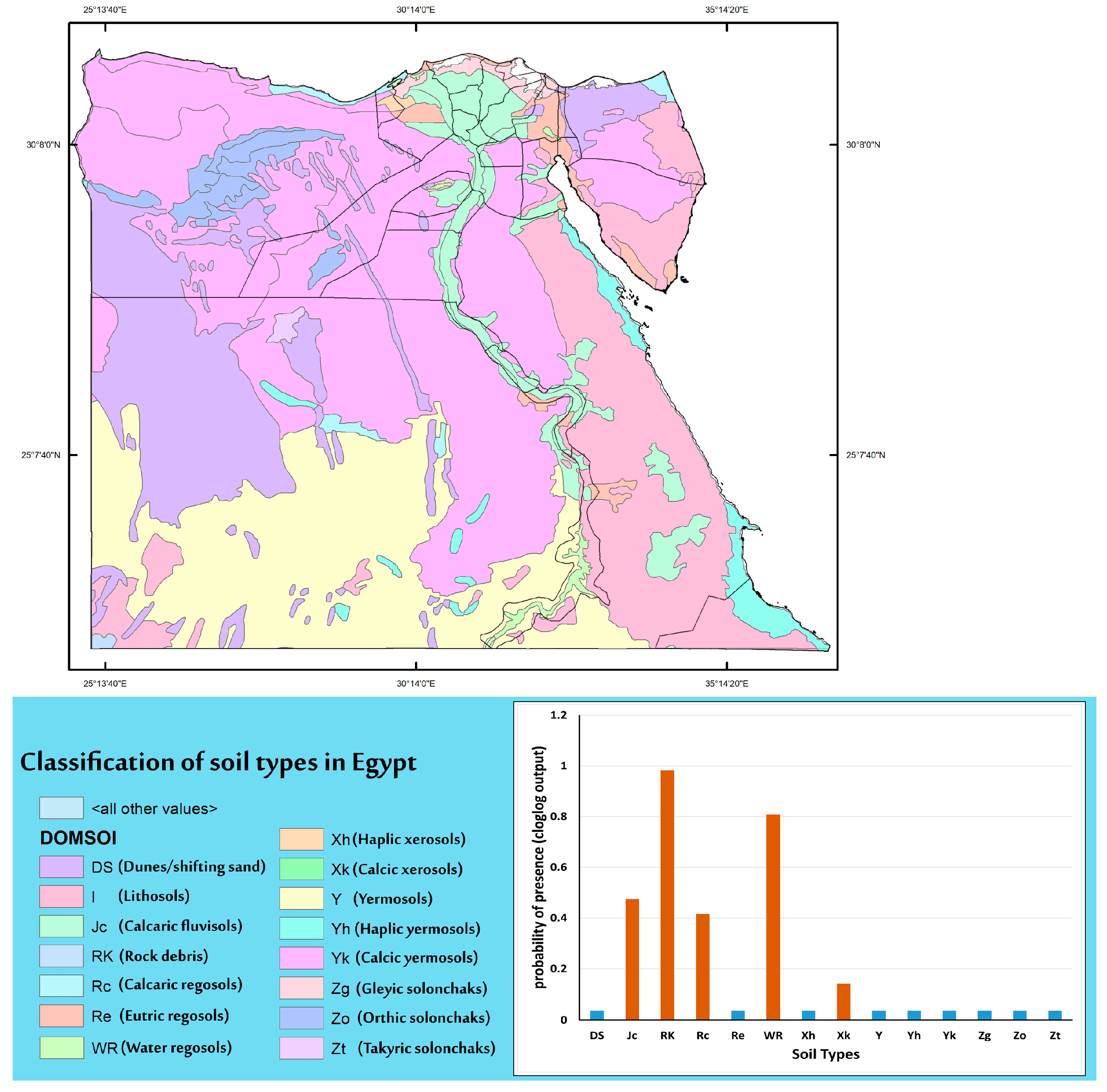
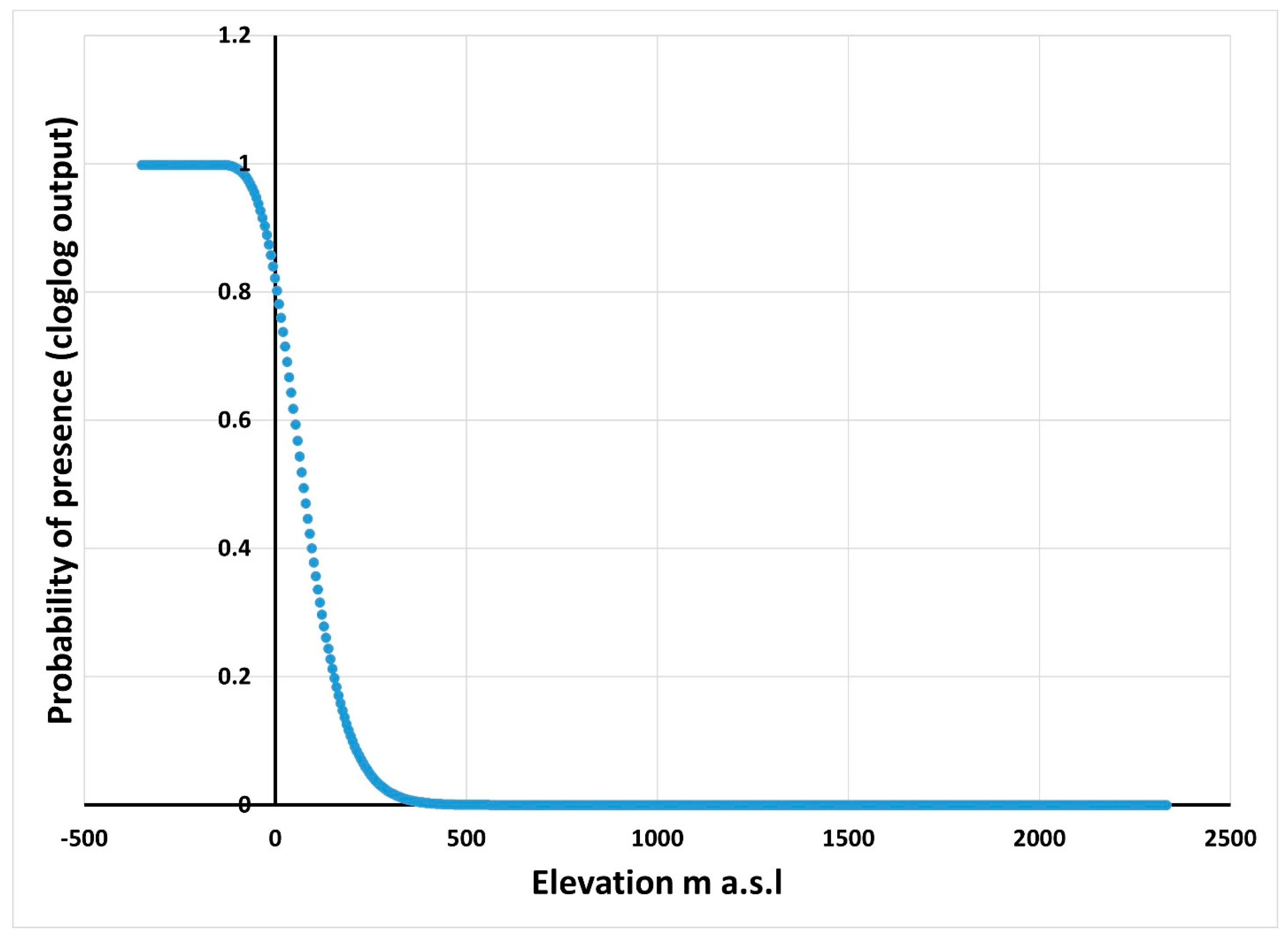
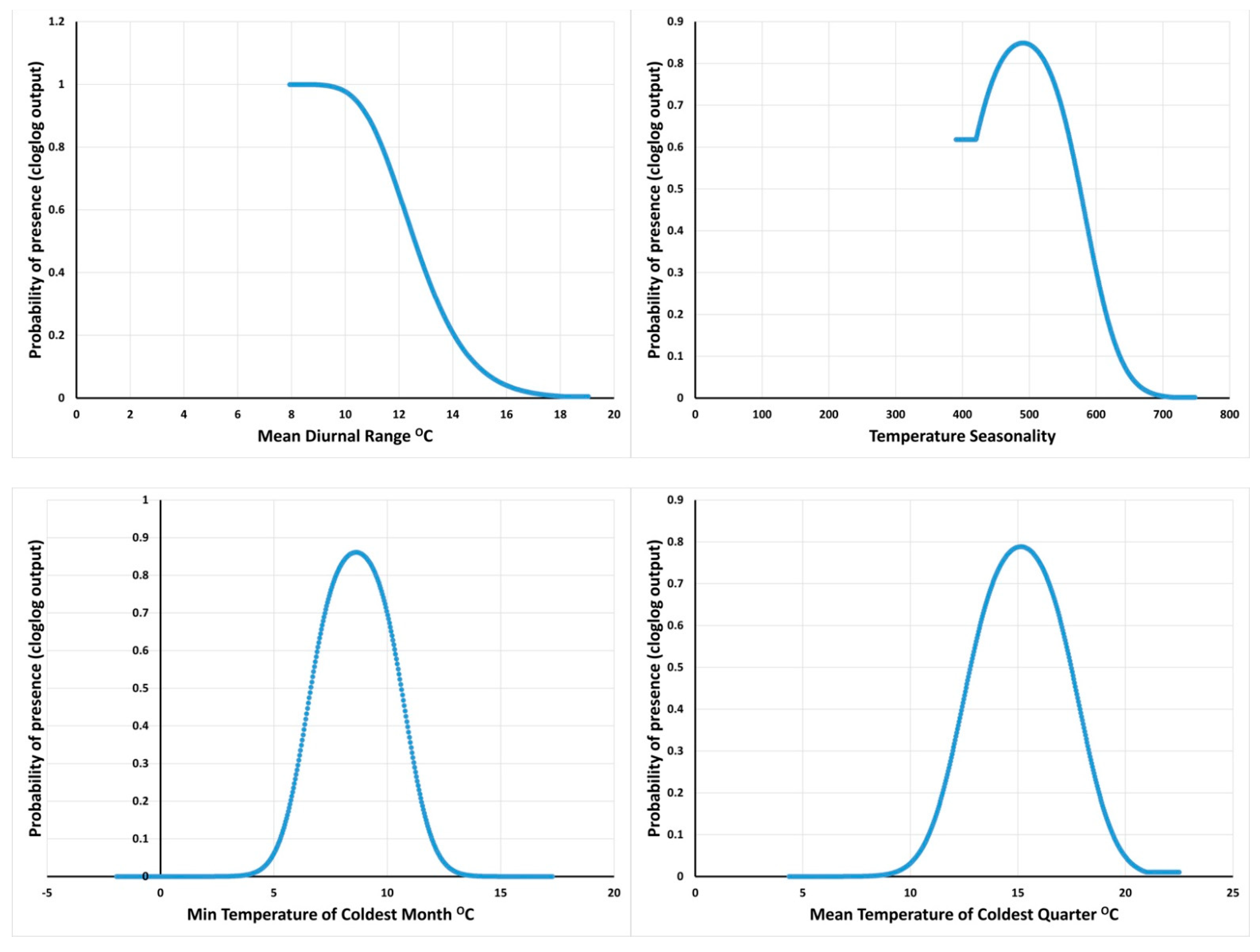

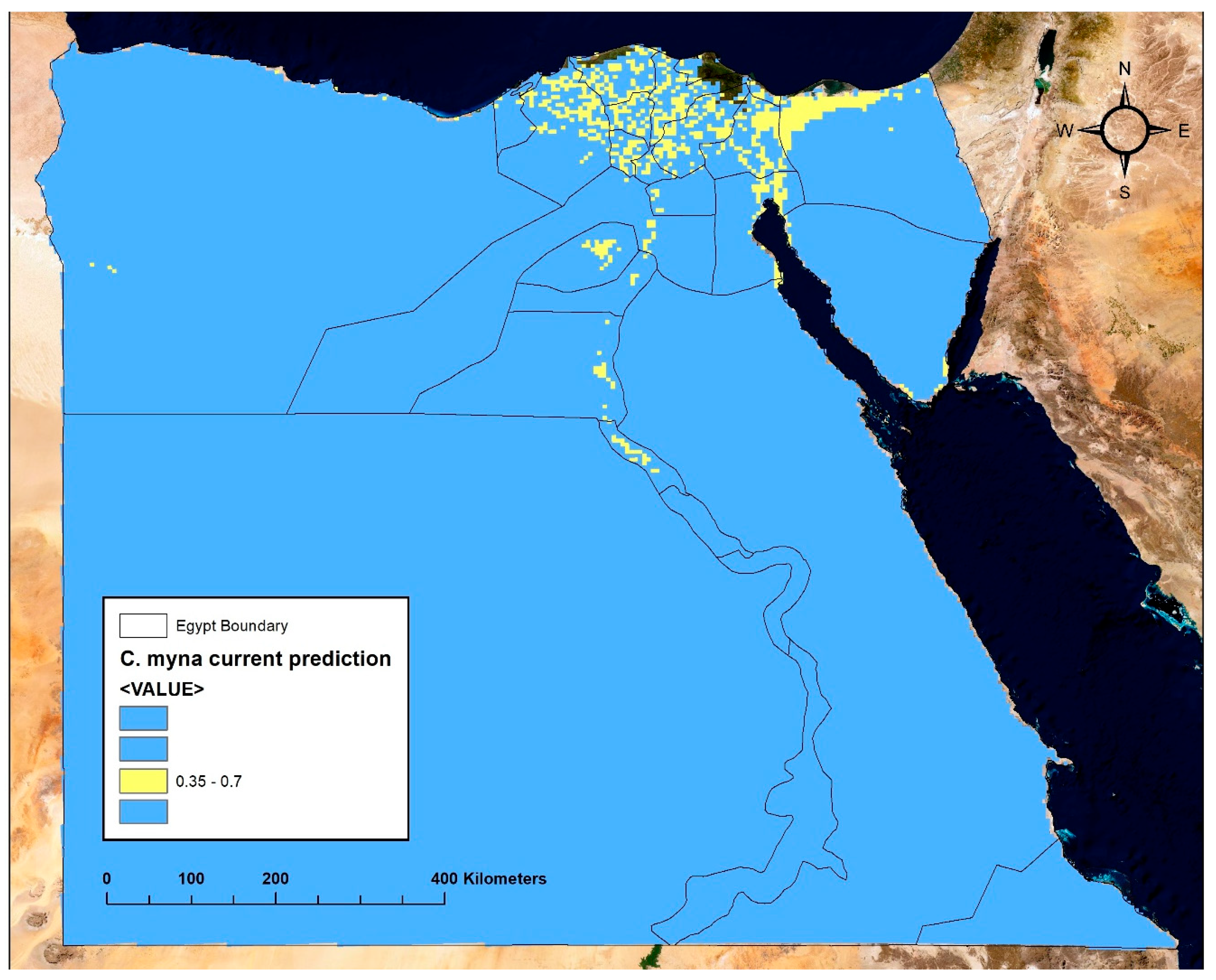

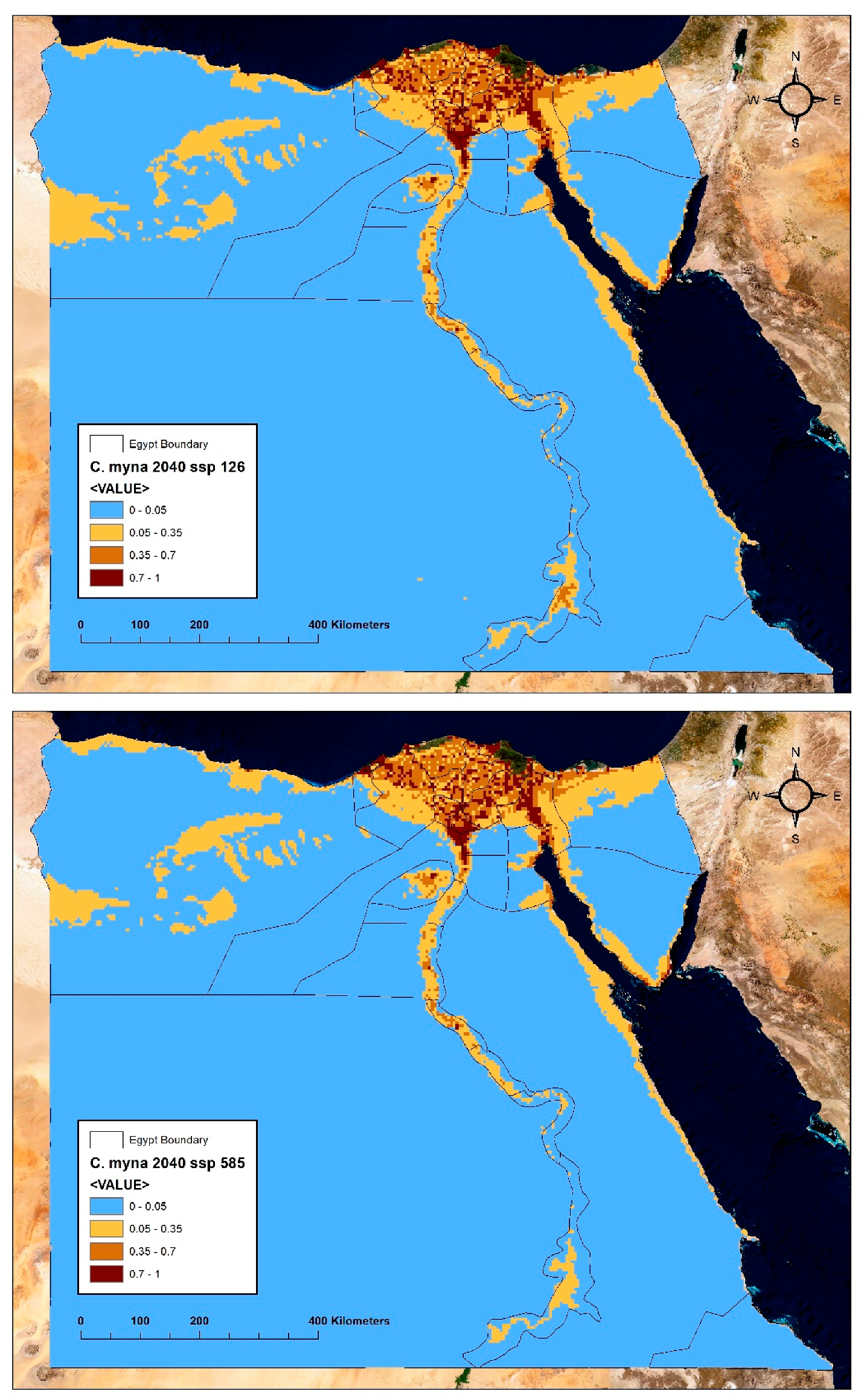


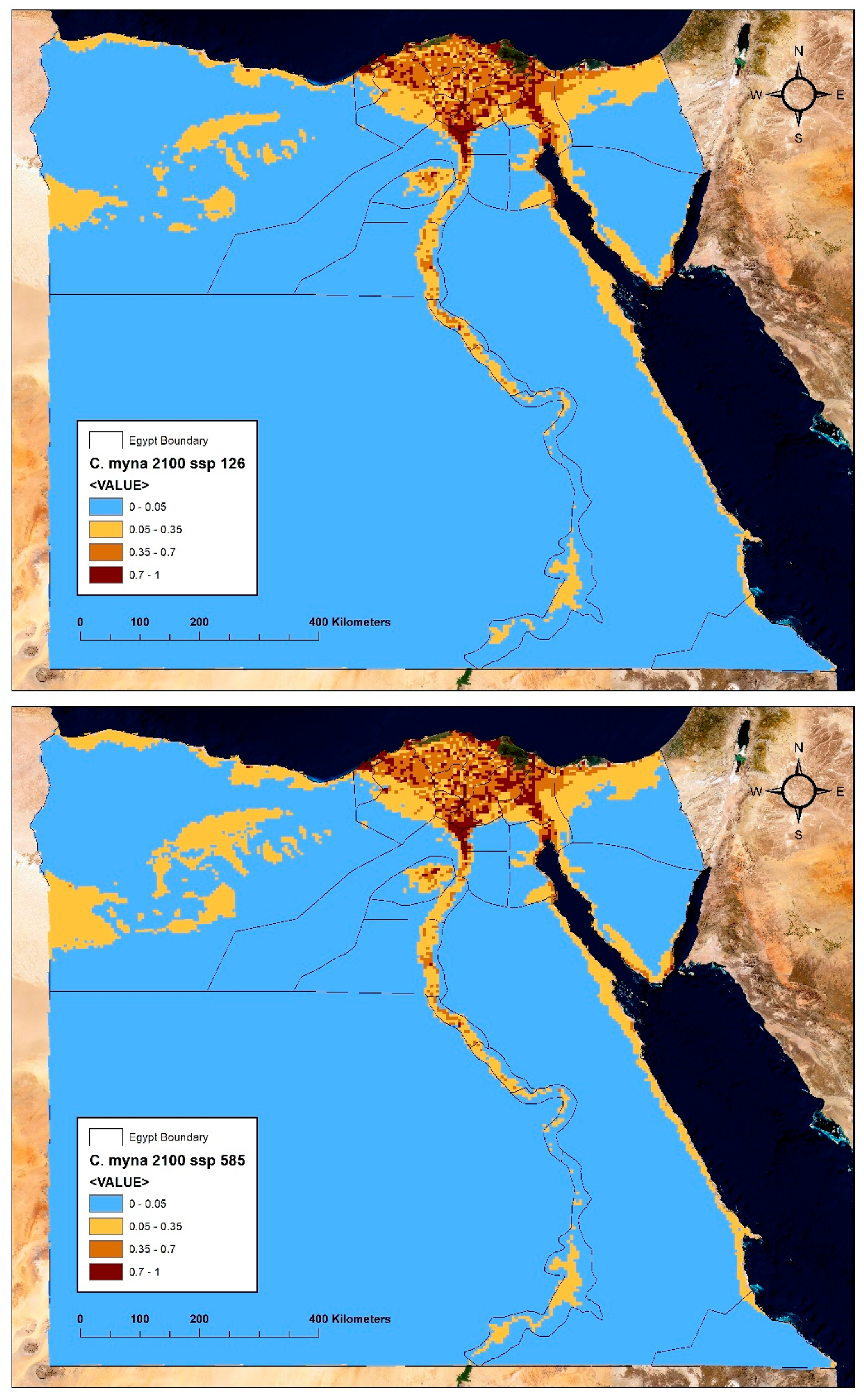

| The Climatic Variables |
|---|
| Temperature variables |
| 1 “Annual Mean Temperature”. |
| 2 “Mean Diurnal Range. |
| 3 “Isothermality “. |
| 4 “Temperature Seasonality”. |
| 5 “Max Temperature of Warmest Month”. |
| 6 “Min Temperature of Coldest Month”. |
| 7 “Temperature Annual Range”. |
| 8 “Mean Temperature of Wettest Quarter”. |
| 9 “Mean Temperature of Driest Quarter”. |
| 10 “Mean Temperature of Warmest Quarter”. |
| 11 “Mean Temperature of Coldest Quarter”. |
| Precipitation variables |
| 12 “Annual Precipitation”. |
| 13 “Precipitation of Wettest Month”. |
| 14 “Precipitation of Driest Month”. |
| 15 “Precipitation Seasonality”. |
| 16 “Precipitation of Wettest Quarter”. |
| 17 “Precipitation of Driest Quarter”. |
| 18 “Precipitation of Warmest Quarter”. |
| 19 “Precipitation of Coldest Quarter”. |
| Variable | Percent Contribution | Permutation Importance |
|---|---|---|
| GHSL-urban-smod | 57.6 | 1.7 |
| Soil type | 16.8 | 3.7 |
| Bio04 | 12.1 | 1.2 |
| Bio02 | 5.8 | 0.3 |
| Landcover | 2.2 | 0.2 |
| Elevation | 1.8 | 10.2 |
| Bio11 | 1.4 | 30.7 |
| Bio15 | 0.9 | 0.7 |
| Bio06 | 0.9 | 50.8 |
| Bio18 | 0.5 | 0.3 |
| Predicted Class | Common MynaPredicted Distribution Range | % |
|---|---|---|
| (0–5%) Unsuitable habitat | 902,673.0528 | 90.5% |
| (6–35%) Poorly suitable habitat | 69,502.45116 | 6.9% |
| (36–70%) Moderately suitable habitat | 16,971.76654 | 1.7% |
| (71–100%) Highly suitable habitat | 8240.508331 | 0.8% |
| Total area | 997,387.7788 | 100% |
| Predicted Class | Current | Future Scenarios | |||||||
|---|---|---|---|---|---|---|---|---|---|
| SSP 126 | SSP 585 | ||||||||
| 2040 | 2060 | 2080 | 2100 | 2040 | 2060 | 2080 | 2100 | ||
| (0–5%) Unsuitable habitat | 902,673.1 | 897,070.3 | 895,782.1 | 893,798.7 | 900,137.5 | 898,440.3 | 895,516.3 | 892,571.8 | 888,748.1 |
| −5602.7 | −6890.9 | −8874.4 | −2535.5 | −4232.7 | −7156.8 | −10,101.3 | −13,925.1 | ||
| (6–35%) Poorly suitable habitat | 69,502.45 | 72,303.8 | 73,796.5 | 75,514.1 | 69,257.1 | 71,036.1 | 73,694.3 | 76,965.9 | 80,810.1 |
| +2801.4 | +4294.1 | +6011.7 | −245.4 | +1533.6 | +4191.8 | +7463.5 | +11,307.7 | ||
| (36–70%) Moderately suitable habitat | 16,971.77 | 19,077.9 | 18,914.3 | 19,159.7 | 19,282.4 | 19,261.9 | 19,057.5 | 18,934.8 | 18,525.8 |
| +2106.1 | +1942.6 | +2187.9 | +2310.6 | +2290.2 | +2085.7 | +1962.9 | +1554.1 | ||
| (71–100%) Highly suitable habitat | 8240.508 | 8935.7 | 8894.8 | 8915.3 | 8710.8 | 8649.5 | 9119.8 | 8915.3 | 9303.8 |
| +695.2 | +654.3 | +674.8 | +470.3 | +408.9 | +879.3 | +674.8 | +1063.3 | ||
Disclaimer/Publisher’s Note: The statements, opinions and data contained in all publications are solely those of the individual author(s) and contributor(s) and not of MDPI and/or the editor(s). MDPI and/or the editor(s) disclaim responsibility for any injury to people or property resulting from any ideas, methods, instructions or products referred to in the content. |
© 2024 by the authors. Licensee MDPI, Basel, Switzerland. This article is an open access article distributed under the terms and conditions of the Creative Commons Attribution (CC BY) license (https://creativecommons.org/licenses/by/4.0/).
Share and Cite
Orabi, G.M.; Semida, F.M.; Medany, D.M.; Issa, M.A.; Ragab, S.H.; Kamel, M. Predicting the Invasion Range of the Common Myna, Acridotheres tristis Linnaeus, 1766 in Egypt under Climate Change. Sustainability 2024, 16, 6495. https://doi.org/10.3390/su16156495
Orabi GM, Semida FM, Medany DM, Issa MA, Ragab SH, Kamel M. Predicting the Invasion Range of the Common Myna, Acridotheres tristis Linnaeus, 1766 in Egypt under Climate Change. Sustainability. 2024; 16(15):6495. https://doi.org/10.3390/su16156495
Chicago/Turabian StyleOrabi, Gamal M., Fayez M. Semida, Doaa M. Medany, Mohamed A. Issa, Sanad H. Ragab, and Mohamed Kamel. 2024. "Predicting the Invasion Range of the Common Myna, Acridotheres tristis Linnaeus, 1766 in Egypt under Climate Change" Sustainability 16, no. 15: 6495. https://doi.org/10.3390/su16156495





